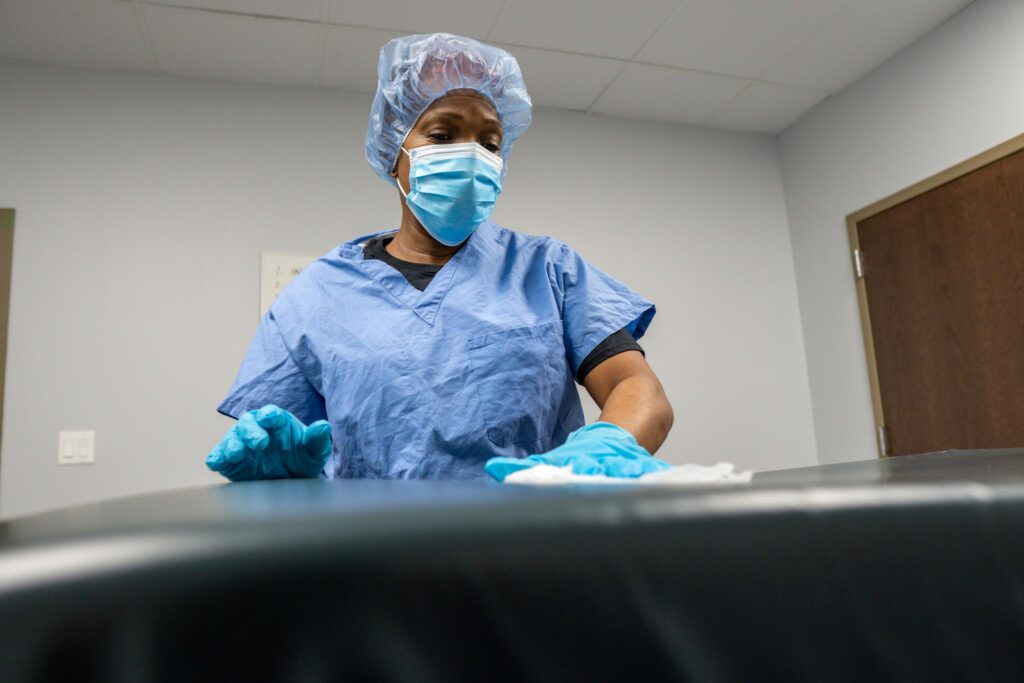Germs, bacteria, and pathogens are everywhere. They’re in the air we breathe, the surfaces we touch, and even the food we eat. As scary as that may seem, it’s not always bad. Small exposure to certain germs when we’re young can help build up our natural immune system and keep our body ready to fight illnesses.
However, when it comes to more transmissible diseases, limiting exposure to germs and pathogens is critical in infection control. This doesn’t require drastic measures like living in a bubble or a constant dedication to disinfection, but it also doesn’t mean you should let germs run amuck in your facility or at home.
To help you create the best plan of attack without going overboard, it’s helpful to understand how long germs can survive outside of the body. To give you a stronger understanding of this, we’ll explore how long common diseases can survive on surfaces and how to protect yourself and others from infection.
How Long Can Germs Survive Outside of the Body
In our daily lives, we encounter a myriad of germs that can cause illnesses and infections. These pathogens can be found on various surfaces, from doorknobs to countertops to our own skin. But how long can these germs survive outside of the body? Let’s explore a few examples below.
The Common Cold
The common cold is a viral infection of the upper respiratory tract that affects millions of people worldwide each year. Although it can be caused by a variety of viruses, the most common culprit is rhinoviruses. Symptoms are usually mild, but a cold can still cause significant discomfort and disruption to daily life—especially if you have an underlying condition.
Rhinoviruses can linger on surfaces for up to 24 hours but become less infectious over time. Viruses generally stay active longer on stainless steel, plastic and similar hard surfaces than on fabric and other soft surfaces. They can also survive on your hands and remain contagious for hours, which is why hand hygiene and disinfecting high-touch points are so important. (Mayo Clinic).
The Flu
The flu is a viral infection that primarily affects the respiratory system. It’s caused by influenza viruses, which can be categorized into different strains. The flu is highly contagious and can spread quickly from person to person through droplets when someone with the virus coughs or sneezes. Symptoms can range from mild to severe, which can cause potentially fatal complications for high-risk populations.
The flu virus can live and potentially infect other people for up to 48 hours after being left behind on a surface. Although the flu virus can survive on hands for only 3 to 5 minutes, if other people later touch a contaminated surface and then touch their eyes, nose, or mouth, they can be exposed to the flu. Colder temperatures can extend their survival time. (CDC)
Coronavirus
Coronavirus refers to a family of viruses that can cause illness in humans and animals. COVID-19 is caused by a novel coronavirus called SARS-CoV-2. Studies indicate that a 99% reduction in infectious SARS-CoV-2 and other coronaviruses can be expected under typical indoor environmental conditions within 3 days (72 hours) on common non-porous surfaces like stainless steel, plastic, and glass. It is important to consider the type of surface for accurate time periods. Regardless, regular cleaning and sanitization are crucial in reducing transmission risks. (CDC)
Escherichia coli (E. coli)
Escherichia coli, commonly known as E. coli, is a type of bacteria that is commonly found in the intestines of humans and animals. While many strains of E. coli are harmless, some can cause serious illnesses, such as urinary tract infections, gastroenteritis, and even kidney failure. E. coli infections can be transmitted through contaminated food, water, or contact with infected animals or people. It can survive outside of the body anywhere from a few hours to a few months, depending on the circumstances of its environment.
Streptococcus pyogenes
Streptococcus pyogenes is a type of bacteria that can cause a variety of infections in humans, such as strep throat, scarlet fever, pneumonia, and more. S. pyogenes infections can be spread through contact with an infected person or contaminated surfaces. On dry surfaces, this bacterium can survive for about three days to six months.
MRSA
MRSA is a strain of Staphylococcus aureus bacteria that is resistant to certain antibiotics, making it more difficult to treat. MRSA infections can occur in the skin, bloodstream, and other parts of the body and can range from mild to severe. In some cases, it can lead to life-threatening complications such as pneumonia, sepsis, or endocarditis. MRSA is spread through skin-to-skin contact with an infected person or through contact with contaminated surfaces or objects.
It’s easy to come in contact with MRSA, as it can survive on surfaces for much longer periods of time. The spores that are formed can live for weeks on fabrics but tends to become inactive on hard surfaces much faster. However, it usually requires more than surface-level skin contact for you to become ill. The best way to reduce your risk is to take preventative measures, regularly clean the surfaces of your facility, and wash fabrics and linens at a minimum of 60°F.
Athlete’s Foot
Athlete’s foot is a type of fungal infection that affects the skin of the feet. It’s common and caused by a group of fungi called dermatophytes, which thrive in warm and moist environments. This is the same type of fungi that’s responsible for ringworm and jock itch. Most commonly, athlete’s foot is spread through direct contact with infected skin or through contact with contaminated surfaces such as floors or towels.
Although it’s not too serious and easily treatable, the fungi can live on surfaces for months to even years. If the area is damp or moist, the fungi can survive indefinitely. Therefore, proper cleaning procedures are absolutely essential in eradicating this common disease from surfaces.
Protozoa
Protozoa are single-celled microorganisms that can be found in a variety of environments, including soil, water, and the bodies of plants and animals. They can range in size, shape, and form. Some protozoa are free-living, while others are parasitic and can cause diseases such as malaria, amoebic dysentery, and giardiasis.
Like the fungi that cause athlete’s foot, protozoa can survive on surfaces for anywhere between a few days to years. Their lifespan depends on the moisture levels and porousness of the material.
Knowing the lifespan of these pathogens is essential to understanding how they spread and how we can prevent infections. By understanding how long these germs can survive outside of the body, we can take the necessary steps to protect ourselves and our loved ones from illness and infection. Maintaining a clean and hygienic environment is crucial in preventing the spread of common diseases and infections, particularly in healthcare facilities.
This is why it is important to choose a reputable cleaning company that understands the necessary protocols for the safe handling and disposal of hazardous materials. Bee Line Support, the region’s leading medical-grade cleaning company, provides unparalleled attention to detail when it comes to cleaning healthcare facilities to keep patients and staff safe and healthy while on-site.
Their team is equipped with the knowledge, supplies, and protocol necessary for eradicating common diseases from surfaces and delivering the highest standards of medical-grade cleaning services. To learn more about their cleaning procedures, receive a quote, or employ their emergency services, contact Bee Line today by calling 312-BEE-LINE.
About The Author
Tom Klimaszewski
author
Tom is your go-to-guy for any health and safety concerns on-site! Tom has lots of experience as a Safety and Compliance Manager in commercial cleaning, healthcare, office, airport settings, with his education in Environmental Studies. He has earned his Certificate Mastery in Infection Prevention (CMIP) and Trainer for Certified Surgical Cleaning Technician (T-CSCT), so to say he’s knowledgeable would be an understatement. When he’s not combatting germs, you can find Tom painting, writing songs, hiking, fishing, and belting out his favorite tunes at karaoke! His favorite part of working with Bee Line is the collaborative and supportive environment.




